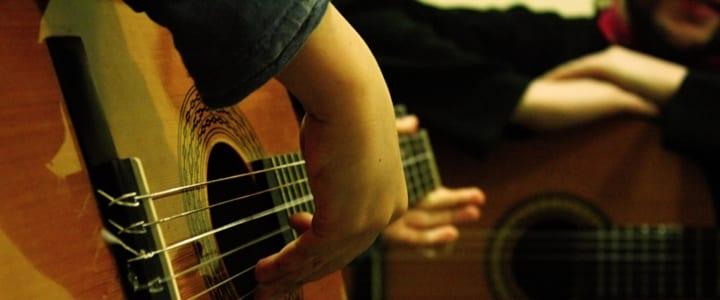We’ve talked about how to read chords and tabs before on the blog — but what about a new approach of learning guitar without sheet music at all? Here, Austin, TX teacher Samuel B. explains his teaching technique…
During my college years, I was given a brief introduction to instructional methods common to Japan. Specifically, I was told that playing the shamisen or the koto (two native stringed instruments) is a skill learned by way of the student facing the teacher and playing what the teacher plays. I continue to use this teaching technique, and feel it has many little-known benefits.
I should begin by making it clear that I’m a kinesthetic learner — I learn by doing more naturally than I do by seeing or hearing. I didn’t even know that I was kinesthetic until I was in my early 30s. Up until that point, I knew of only two orientations (visual and auditory) and I had no idea which one I was.
I began learning guitar — the blues, specifically — by hearing the music of Delta artists such as Mississippi John Hurt and Robert Johnson while I was in my teens, and I began developing my adaptations of their techniques simply by building on basic first-position (first three frets) chord patterns, which most of my students master in fewer than five lessons. I picked out various riffs that now seem to me to have been more like tributes to these giants of the form than actual attempts to imitate them. In reality, I was just experimenting.
How I Teach My Students
These experiments have given way to effective instructional techniques based squarely on factors such as your coordination and the development of your left-hand muscles. “F” in first position is a good example. Given that the chord involves holding down two strings with one finger, I taught my first student to play each half of the chord (the index finger holding the first and second strings, the third and fourth fingers holding down the third and fourth strings). Several go-arounds of playing each half of the chord solidified her understanding of it to the point of her now playing it as proficiently as I do.
Learning guitar doesn’t have to include sheet music. In fact, I’ve never actually taught with it, because I regard it as an emotionless third party to my very personal teaching style, which is tailored as closely as possible to your individual needs and rate of progress. I’m committed to focusing squarely on your gradual accumulation of knowledge, confidence, and personal initiative beginning literally on the very first note. I believe that sheet music widens the distance between you and I, producing weaker results that the ones achieved by imitation. As a former classroom teacher (who still retains a New Jersey-based K-8 certificate), I’m a veteran of alternative education that provides exactly this — fluid individualized instruction with minimal deadlines that develops your personal strengths rather than your ability and/or willingness to assimilate.
I’m remembering a scene in the film “Hoosiers” in which the coach reminds the team that the dimensions of the hoop and the backboard (width and distance from the floor) are EXACTLY the same on the state championship court as they are in the small-town gym back home. Similarly, I will remind you of the following:
- The progression of triads in the middle of the neck are the EXACT SAME chords you will have learned in first position during your introduction to the blues. As you are learning guitar with me, you will learn “Sweet Home Chicago” and “How Long Blues” (or similar tunes) involving the first-position versions E, A, and B7. Afterward, the fifth-position triad version of “Mailbox Blues” will be taught.
- Any scale can be transposed to another key in another position. It’s easy to lose sight of the identical fingering of a scale in first position (which typically involves playing open strings) and its counterparts elsewhere, which involve using the left index finger to play the transposed versions of the open-stringed first-position notes. As you may have guessed, I will merely be teaching you different versions of the same thing and/or the same thing in different keys.
My body of musical knowledge is not exclusive to only one genre. I specialize in folk, rock, blues, and (some) jazz. I consider it fitting to create a space where you can explore your preferences of genres, playing styles, and hand-strengthening processes, in a space squarely conducive to the development of all three. “You cannot teach (a person) anything,” said Galileo. “You can only help (the person) find it within.”
 Samuel B. teaches beginner guitar lessons in Austin, TX. He teaches lessons face-to-face without sheet music, which is his adaptation of Japanese instruction (involving a call-and-response method). Learn more about Samuel here!
Samuel B. teaches beginner guitar lessons in Austin, TX. He teaches lessons face-to-face without sheet music, which is his adaptation of Japanese instruction (involving a call-and-response method). Learn more about Samuel here!
Photo by Nadia Blagorodnova
Suzy S.


